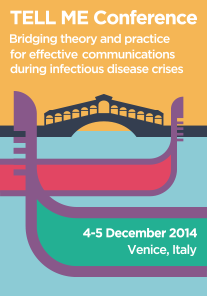Infectious disease outbreak
Risk communication is an interactive process of exchange of information and opinion on risk among risk assessors, risk managers, and other interested parties. It is most effective when integrated with risk analysis and risk management and requires the involvement of stakeholders. Problems for risk communicators involve how to reach the intended audience, to make the risk comprehensible and relatable to other risks, how to pay appropriate respect to the audience's values related to the risk, how to predict the audience's response to the communication, etc. A main goal of risk communication is to improve collective and individual decision making.
The U.S. Environmental Protection Agency expressed seven cardinal rules for the practice of risk communication:
- accept and involve the public/other consumers as legitimate partners (e.g. stakeholders);
- plan carefully and evaluate your efforts with a focus on your strengths, weaknesses, opportunities, and threats (SWOT);
- listen to the stakeholders specific concerns;
- be honest, frank, and open;
- coordinate and collaborate with other credible sources;
- meet the needs of the media;
- speak clearly and with compassion.
An outbreak is a sudden rise in the occurrence (the number of cases) of a disease. Some outbreaks are expected each year, like influenza, hand-foot-and-mouth disease, and bronchiolitis. This term might be used when a single case of an unusual disease occurs. In 2006, a team of researchers, epidemiologists and informaticians at Children's Hospital Boston developed HealthMap, an online tool for disease outbreak monitoring and real-time surveillance of emerging public health threats.
The definition of an influenza pandemic given by the World Health Organization (WHO) states that “an influenza pandemic occurs when a new influenza virus appears against which the human population has no immunity, resulting in several simultaneous epidemics worldwide with enormous numbers of deaths and illness”.
Such a definition has been changed in 2009, in concomitance with the H1N1 influenza outbreak, and lost part of its severe meaning (see also Swine flu).
The occurrence of pandemics is rare, and are different compared to regular seasonal epidemics of influenza. The most severe influenza pandemic in recent history was the 1918 Spanish flu, which is estimated being responsible for the deaths of over 50 million people.
An outbreak is a sudden rise in the occurrence (the number of cases) of a disease. Some outbreaks are expected each year, like influenza, hand-foot-and-mouth disease, and bronchiolitis. This term might be used when a single case of an unusual disease occurs. In 2006, a team of researchers, epidemiologists and informaticians at Children's Hospital Boston developed HealthMap, an online tool for disease outbreak monitoring and real-time surveillance of emerging public health threats.
FluID. Flu Informed Decision is a global platform for data sharing developed by the WHO. It links regional influenza epidemiological data into a single global database. The platform provides connections between existing databases and can also be used to enter data directly through a web-based interface, if desired. It complements the existing virological data collection tool FluNet. The platform accommodates both qualitative and quantitative data which facilitates the tracking of global trends, spread, intensity, and impact of influenza. These data are made freely available to health policy makers in order to assist them in making informed decisions regarding the management of influenza.
Flu Wiki. The purpose of the Flu Wiki is to help local communities prepare for and perhaps cope with a possible influenza pandemic. This is a task previously ceded to local, state and national governmental public health agencies. The goal is to be:
- a reliable source of information, as neutral as possible, about important facts useful for a public health approach to pandemic influenza;
- a venue for anticipating the vast range of problems that may arise if a pandemic does occur;
- a venue for thinking about implementable solutions to foreseeable problems.
Swine influenza, also called pig influenza, “swine flu”, “hog flu” and “pig flu”, is an infection caused by any one of several types of swine influenza viruses, including influenza C virus and the subtypes of influenza A (H1N1, H1N2, H2N1, H3N1, H3N2, and H2N3). Swine influenza virus is common throughout pig populations worldwide. Transmission of the virus from pigs to humans is not common and does not always lead to human flu, often resulting only in the production of antibodies in the blood. If transmission does cause human flu, it is called zoonotic swine flu. People with regular exposure to pigs are at increased risk of swine flu infection. Symptoms of zoonotic swine flu in humans are similar to those of influenza and of influenza-like illness in general, namely chills, fever, sore throat, muscle pains, severe headache, coughing, weakness and general discomfort.
In April 2009, a new strain of H1N1 virus, responsible for human influenza, was originally referred to as “swine flu” because laboratory testing showed that many of the genes in the virus were very similar to influenza viruses that normally occur in pigs in North America. However, further study has shown that the 2009 H1N1 is very different from what normally circulates in North American pigs. It has two genes from flu viruses that normally circulate in pigs in Europe and Asia and others from bird (avian) genes and human flu viruses genes. Scientists call this a "quadruple reassortant" virus.
Despite its name, the H1N1 “swine flu” virus cannot be spread by eating pork or pork products and, similar to other influenza viruses, it is typically contracted by person to person transmission through respiratory droplets. Symptoms usually last 4–6 days. Unlike most strains of influenza, H1N1 does not disproportionately infect adults older than 60 years. This virus (Probably due to previous exposure to a similar H1N1 virus) was first detected in people in the United States in April 2009 and it was as a pandemic by the World Health Organization in June 2009. It spread worldwide and, as of May 30 2010, 18138 deaths have been reported. On August 10, 2010, the World Health Organization declared the H1N1 influenza pandemic over, saying worldwide flu activity had returned to typical seasonal patterns.
An intense debate arose about the declaration of the “swine flu” as a pandemic. Critics claimed the WHO had exaggerated the danger, spreading fear and confusion rather than immediate information.
A flu follow-up study done in September 2010, found that "the risk of most serious complications was not elevated in adults or children". A 2011 study estimated that the 2009 H1N1 global infection rate was 11% to 21% lower than what was previously expected while another one, published in 2012, showed that as many as 579,000 people could have been killed by the disease, as only those fatalities confirmed by laboratory testing were included in the original number, and meant that many of those without access to health facilities went uncounted. The majority of these deaths occurred in Africa and South East Asia.
An outbreak is a sudden rise in the occurrence (the number of cases) of a disease. Some outbreaks are expected each year, like influenza, hand-foot-and-mouth disease, and bronchiolitis. This term might be used when a single case of an unusual disease occurs. In 2006, a team of researchers, epidemiologists and informaticians at Children's Hospital Boston developed HealthMap, an online tool for disease outbreak monitoring and real-time surveillance of emerging public health threats.


